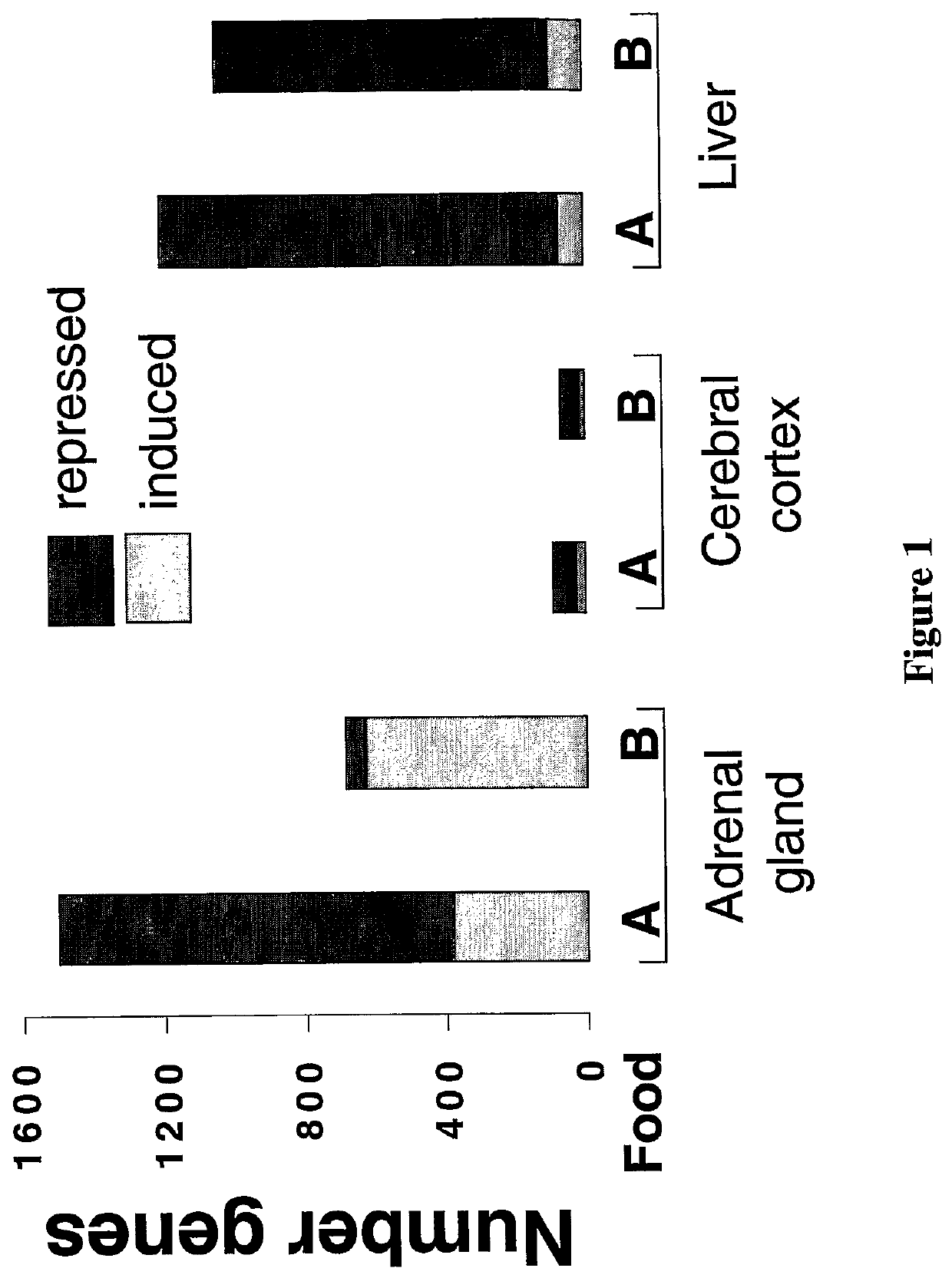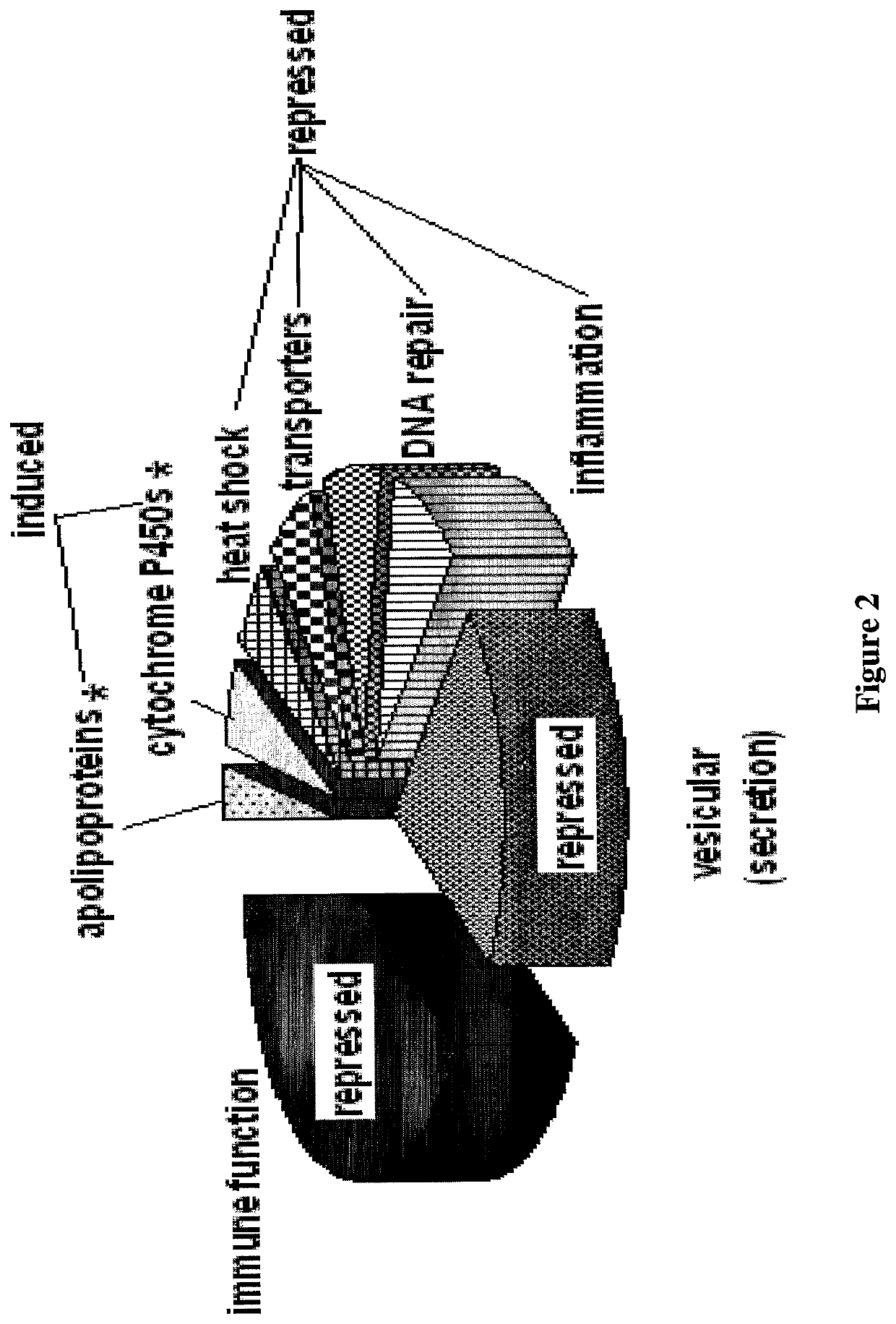Use of antioxidants for gene modulation
a technology of gene expression and antioxidants, applied in the field of gene expression modulation in senescent mammals, can solve problems such as progressive deterioration of the biological system, and achieve the effect of modulating gene expression
- Summary
- Abstract
- Description
- Claims
- Application Information
AI Technical Summary
Benefits of technology
Problems solved by technology
Method used
Image
Examples
example 1
[0083]This example illustrates mitigation of oxidative stress experienced by senescent mice fed various antioxidants as determined using biochemical measures of the ratio of reduced to oxidized glutathione (GSH:GSSG) as an indicator of oxidative stress.
[0084]GSH:GSSG ratios were measured by the method described in Jones, D. P., Redox Potential of GSH / GSSG Couple: Assay and Biological Significance, METHODS ENZYMOL., 348:93-112 (2002).
[0085]Senescence-Accelerated Mouse (SAM) strain, which provides a model system for aging, was obtained from Dr. T. Takeda and the council on SAM research, University of Tokyo, Tokyo, Japan (Takeda T. et al., Senescence-accelerated mouse (SAM): A novel murine model of senescence, Exp Gerontol, 32:105-109 (1997); Takeda T. et al., Pathobiology of the senescence-accelerated mouse (SAM), Exp Gerontol, 32:117-127 (1997); Takeda T., Senescence-accelerated mouse (SAM): A biogerontological resource in aging research, Neurobiol Aging, 20:105-110 (1999)).
[0086]C57...
example 2
[0098]The genomic response to antioxidant(s) in senescence accelerated mice fed various antioxidant-comprising foods were determined by mRNA expression analysis.
[0099]Three groups of 5-6 senescence-accelerated mice were fed control food, food A, or food B as explained in Example 1 above. The compositions of the foods were as in Example 1 above as well.
[0100]Molecular biology techniques follow standard protocols well known to skilled artisans, such as those set forth in Sambrook et al., Molecular Cloning: A Laboratory Manual, 2nd ed. Cold Spring Harbor Laboratory Press, Cold Spring Harbor, N.Y. (1989). Tissue was obtained from mice, and RNA was extracted from that tissue. The extracted RNA was pooled by tissue (liver, adrenal gland, and cerebral cortex) and food (control, A, or B), resulting in a total of nine pooled RNA samples. The pooled total RNA samples were further processed to obtain gene (mRNA) expressions using Mu74Av2 high density oligonucleotide arrays (Mu74Av2 GeneChip, A...
example 3
[0106]The effects of foods A and B on expression of various classes of genes in various tissues of senescence accelerated mice were determined using the GeneChip assay described above.
[0107]FIGS. 2, 3, and 4 summarize the functional classes of genes whose expression is modulated in mice fed foods A and B and the relative contribution of those genes to the changes in gene profiles.
[0108]FIGS. 2 and 3 show an overview of the functional classes of adrenal gland and liver genes, respectively, that are affected by foods A and B and their relative distributions. Foods A and B had repressive effects on the functional groups of genes illustrated in FIGS. 2 and 3. Largest numbers of the affected genes regulate immune functions. Similarly, genes that regulate inflammation, secretion, response to DNA damage, and heat shock were also down regulated by foods A and B in liver and the adrenal gland. Genes that encode enzymes of glycolysis, mitochondrial oxidations, and protein synthesis were downr...
PUM
| Property | Measurement | Unit |
|---|---|---|
| oxidative stress | aaaaa | aaaaa |
| heat shock | aaaaa | aaaaa |
| antioxidant | aaaaa | aaaaa |
Abstract
Description
Claims
Application Information
 Login to view more
Login to view more - R&D Engineer
- R&D Manager
- IP Professional
- Industry Leading Data Capabilities
- Powerful AI technology
- Patent DNA Extraction
Browse by: Latest US Patents, China's latest patents, Technical Efficacy Thesaurus, Application Domain, Technology Topic.
© 2024 PatSnap. All rights reserved.Legal|Privacy policy|Modern Slavery Act Transparency Statement|Sitemap



